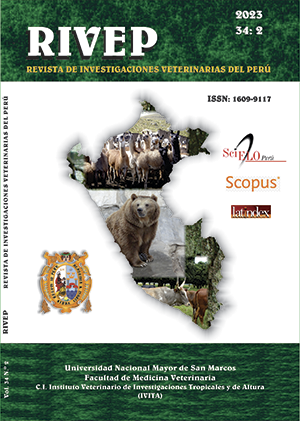Fibre density and density of hair ducts as selection criteria to improve the quality and weight of alpaca fleece
DOI:
https://doi.org/10.15381/rivep.v34i2.25102Keywords:
animal breeding, fibre density, fibre diameter, fleece weight, South American Camelids, luxury fibresAbstract
Improvements in the weight of greasy fleece (GFW) and mean fibre diameter (MED) can favour the income of alpaca producers; however, these variables are directly related, complicating the simultaneous improvement of both characteristics. Therefore, it is necessary to find new selection criteria for the simultaneous improvement of both characteristics. The purpose of the study was to characterize the fibre density (FibDen), density of hair ducts (DenDucts) and the fibre/duct ratio and No. of fibres/ducts (Fib/Duct_R) as possible selection criteria. Likewise, determine the type of relationship between them and with GFW and MFD, and construct and evaluate formal selection indices under scenarios with different available measurements, considering in all cases GFW and MFD duly weighted by their economic weights, as selection objectives. For this, fibre samples and skin images were taken, and the GFW of alpacas from four herds raised in Huancavelica and Caylloma, Arequipa, Perú, between 2018 and 2020 were recorded. The density characteristics were obtained through the procedure called Fiber Den, while the FMD was assessed using the FIBER EC, and GFW was recorded using a scale. In the construction of the selection indices for GFW and MFD Hazel's theory of selection indices was applied, considering the values indicated in the bibliography and in the present study. The FibDen, DenDucts and Fib/Ducts_R ranged from 8.8 to 60 fib/mm2, 3.8 to 21.2 ducts/mm2 and 2.0 to 4.3 fib/ducts, respectively. There are hair ducts with up to 8 fibres, the most frequent being ducts with 1, 2 or 3 fibres. It is concluded that FibDen and DenDcuts have a linear and direct relationship with the GFW and inversely with the MFD, and that the inclusion of the FibDen and DenDucts as selection criteria within a selection index would improve the accuracy from 0.53 to 0.63, being able to obtain further progress genetic between 15 and 18%, with better economic benefits than when only GFW and MFD are used.
Downloads
Downloads
Published
Issue
Section
License
Copyright (c) 2023 Edgar Carlos Quispe Peña, Rolando Rivera Quinto, Marco Espinoza Castillo, Verónica Flores Alca, Max Quispe Bonilla, Joaquín Pablo Mueller

This work is licensed under a Creative Commons Attribution 4.0 International License.
AUTHORS RETAIN THEIR RIGHTS:
a. Authors retain their trade mark rights and patent, and also on any process or procedure described in the article.
b. Authors retain their right to share, copy, distribute, perform and publicly communicate their article (eg, to place their article in an institutional repository or publish it in a book), with an acknowledgment of its initial publication in the Revista de Investigaciones Veterinarias del Perú (RIVEP).
c. Authors retain theirs right to make a subsequent publication of their work, to use the article or any part thereof (eg a compilation of his papers, lecture notes, thesis, or a book), always indicating the source of publication (the originator of the work, journal, volume, number and date).










